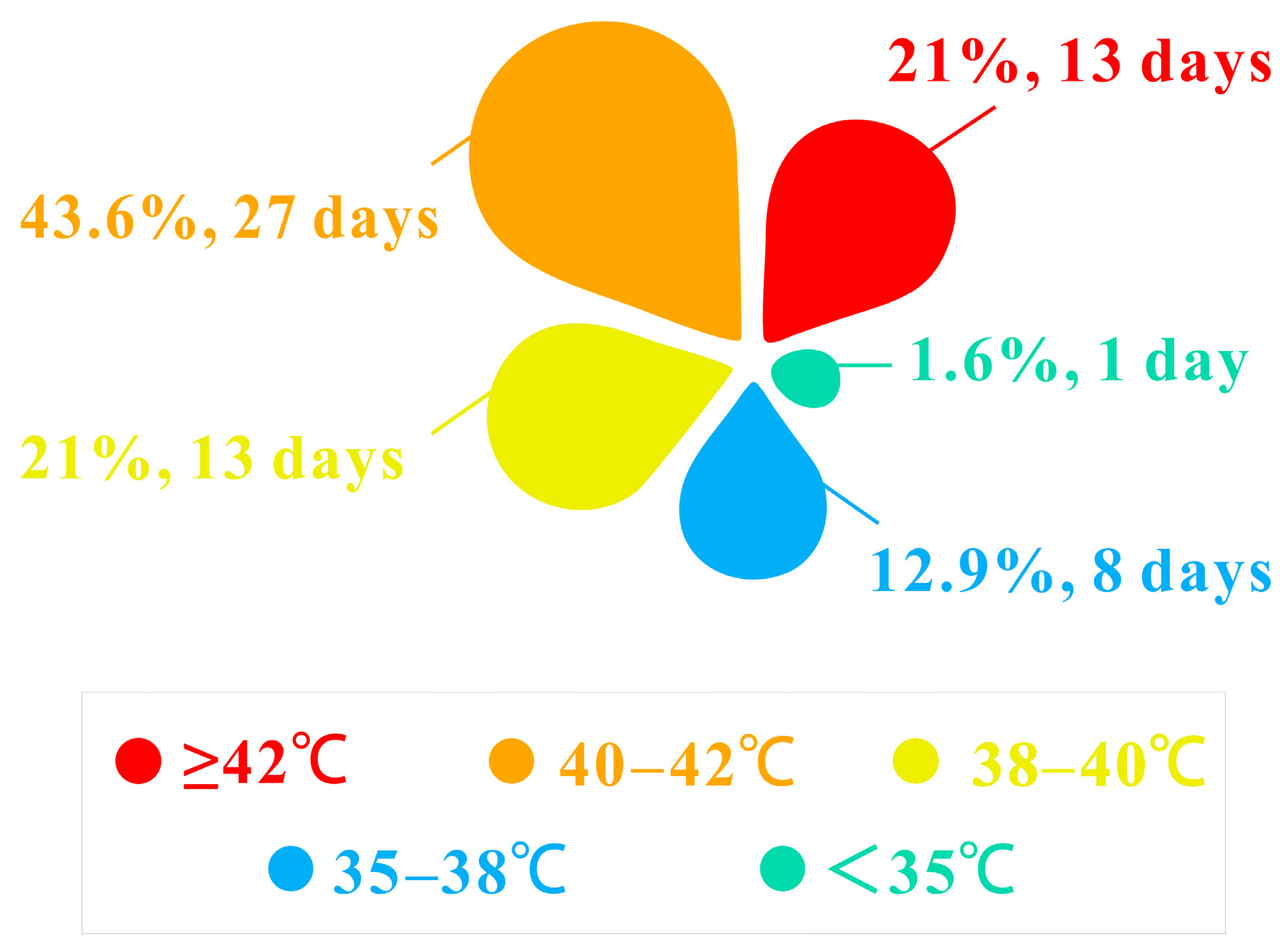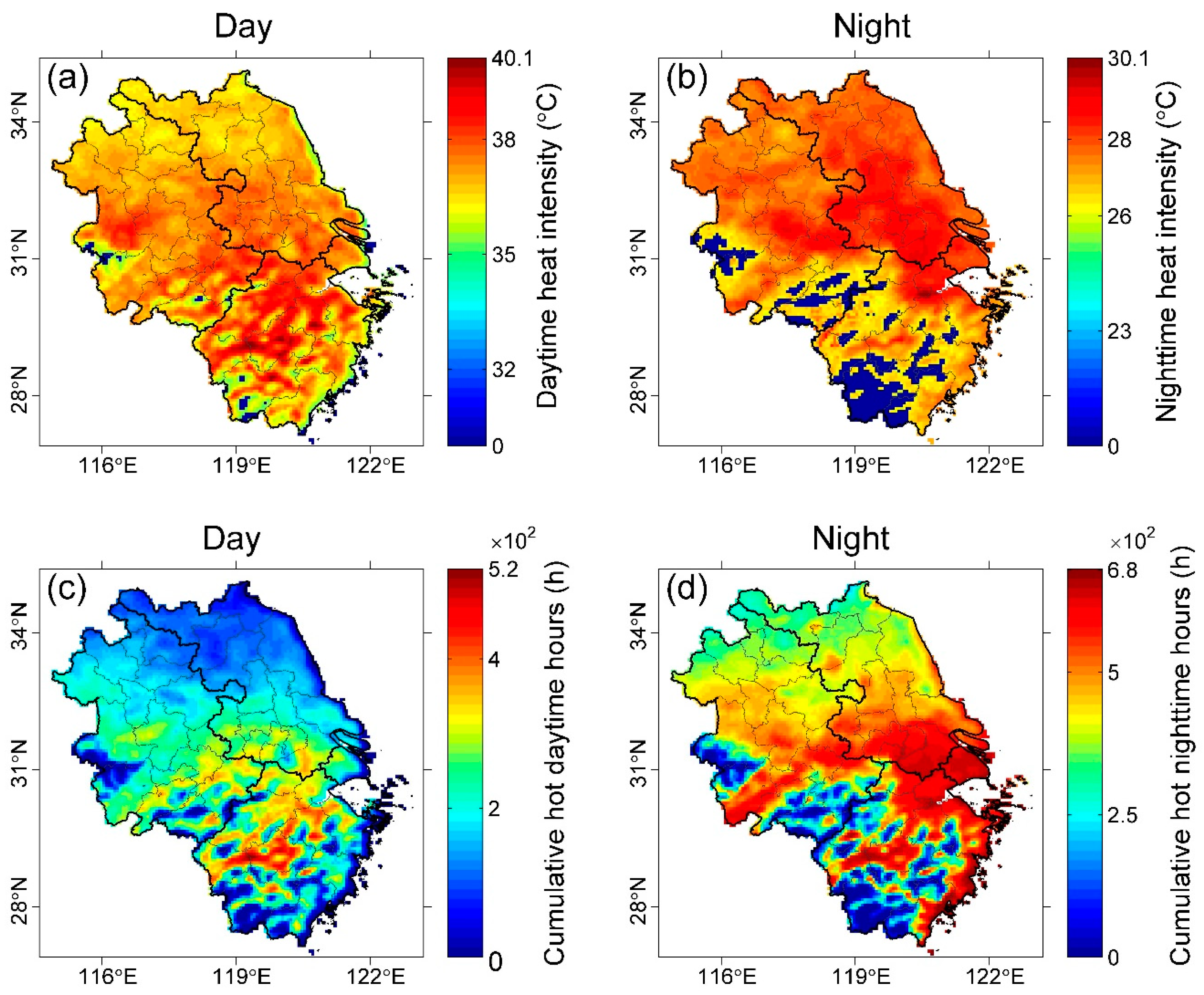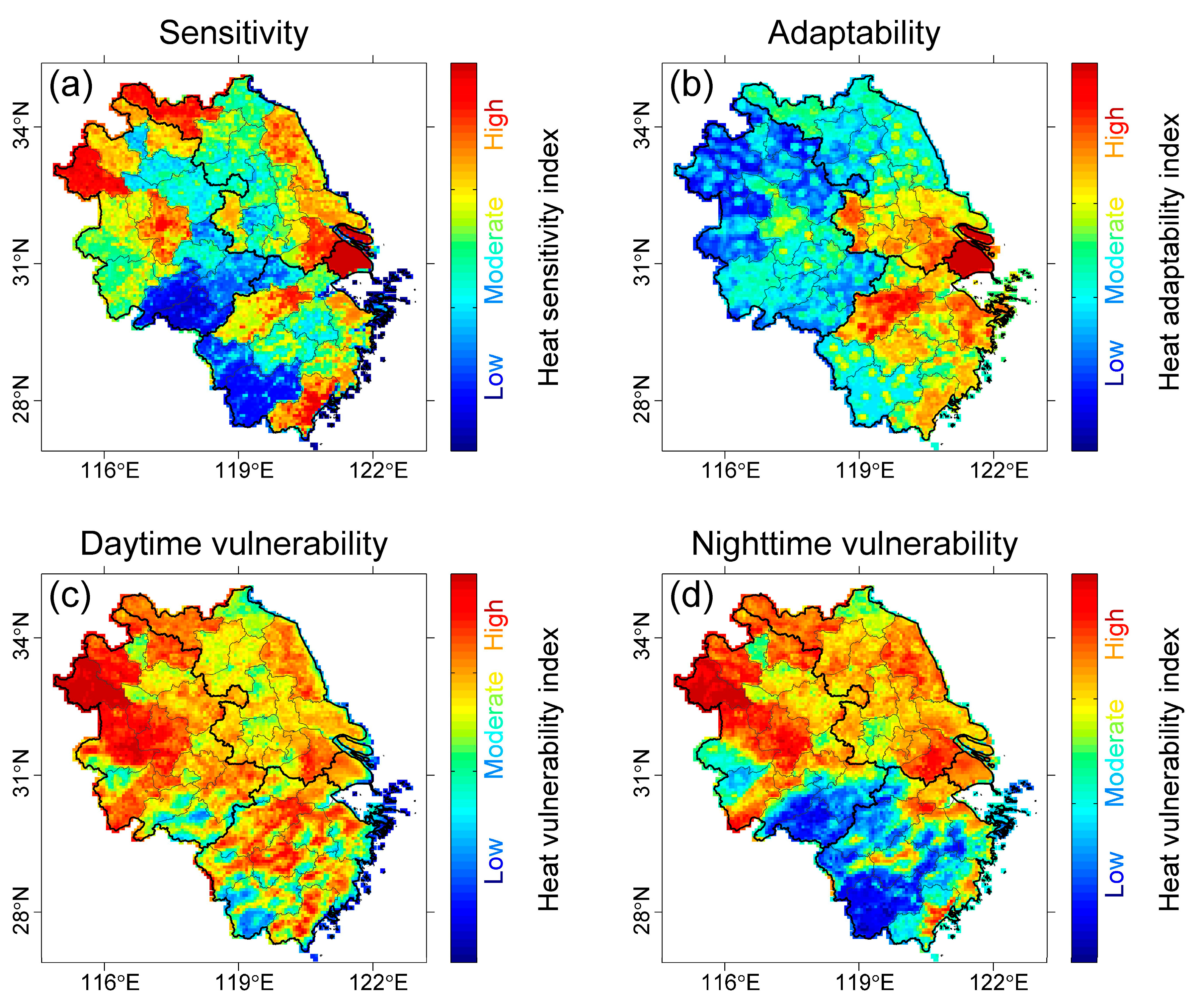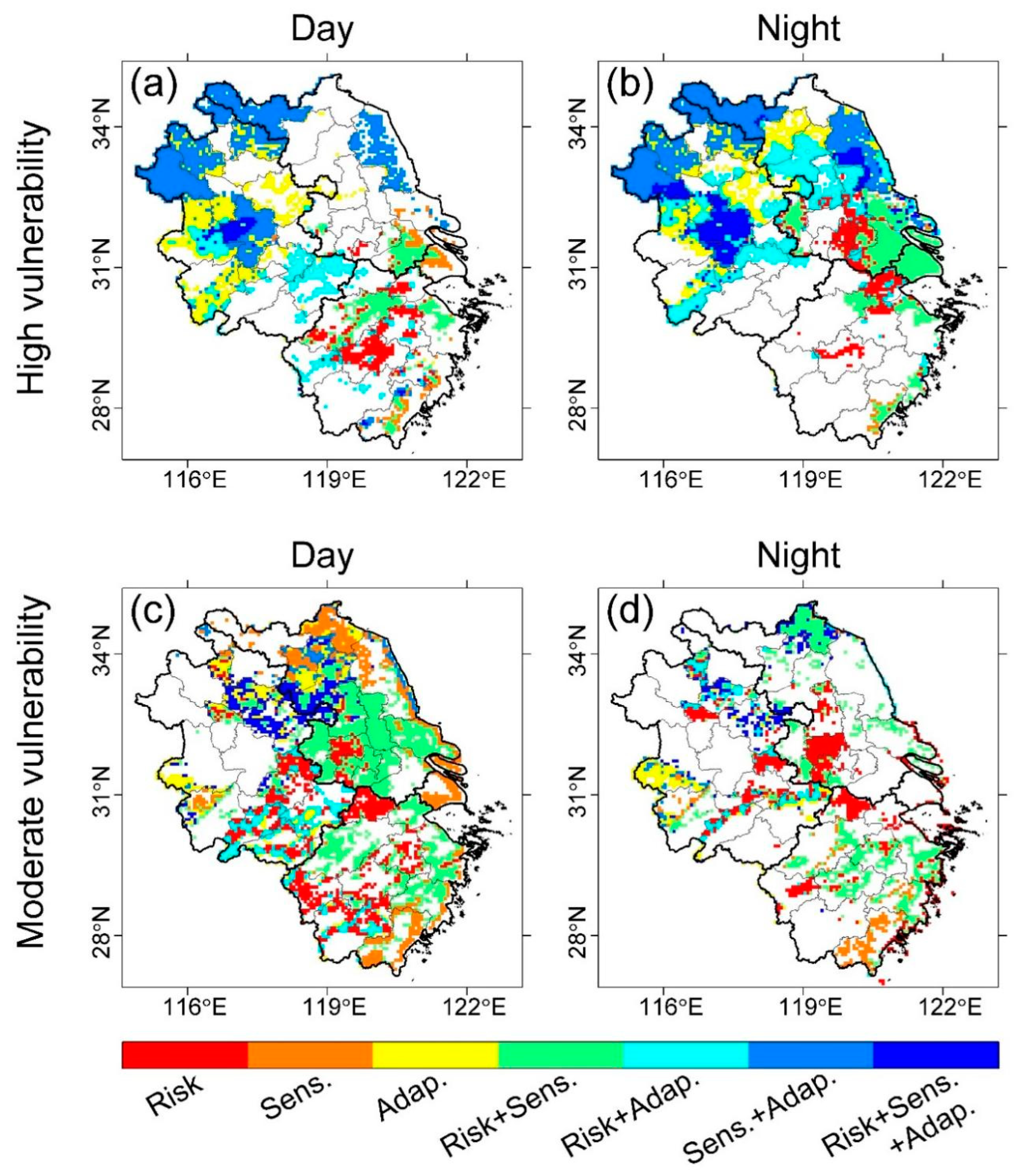Compound Heat Vulnerability in the Record-Breaking Hot Summer of 2022 over the Yangtze River Delta Region
Abstract
:1. Introduction
2. Materials and Methods
3. Results
3.1. Strong Heat Intensity and Heat Frequency in the YRD Region during Both Daytime and Nighttime
3.2. Strong Heat Risk, Strong Heat Sensitivity and Low Heat Adaptability in Most Areas of the YRD Region
3.3. Distributions and Causes of Compound Heat Vulnerability in the YRD Region
4. Discussion
5. Conclusions
Funding
Institutional Review Board Statement
Informed Consent Statement
Data Availability Statement
Acknowledgments
Conflicts of Interest
References
- Luo, D.; Liang, L.; Wang, Z.; Chen, L.; Zhang, F. Exploration of coupling effects in the economy–society–environment system in urban areas: Case study of the Yangtze River Delta urban agglomeration. Ecol. Indic. 2021, 128, 107858. [Google Scholar]
- Gu, S.; Jin, Y.; Lu, B.; Wang, A.; Zhang, D. Evaluation of excess mortality risk related to heat wave in Ningbo from 2013 to 2018. J. Prev. Med. 2021, 12, 897–901. [Google Scholar]
- Ma, W.; Zeng, W.; Zhou, M.; Wang, L.; Rutherford, S.; Lin, H.; Liu, T.; Zhang, Y.; Xiao, J.; Zhang, Y.; et al. The short-term effect of heat waves on mortality and its modifiers in China: An analysis from 66 communities. Environ. Int. 2015, 75, 103–109. [Google Scholar] [CrossRef] [PubMed]
- Hu, K.; Yang, X.; Zhong, J.; Fei, F.; Qi, J. Spatially explicit mapping of heat health risk utilizing environmental and socioeconomic data. Environ. Sci. Technol. 2017, 51, 1498–1507. [Google Scholar] [CrossRef] [PubMed]
- Ji, J.S. Heatwave sears China: Need for actionable climate change adaptation to protect public health. Lancet Reg. Health–West. Pac. 2022, 25, 100568. [Google Scholar] [CrossRef]
- Raymond, C.; Matthews, T.; Horton, R.M. The emergence of heat and humidity too severe for human tolerance. Sci. Adv. 2020, 6, eaaw1838. [Google Scholar] [CrossRef]
- Faurie, C.; Varghese, B.M.; Liu, J.; Bi, P. Association between high temperature and heatwaves with heat-related illnesses: A systematic review and meta-analysis. Sci. Total Environ. 2022, 852, 158332. [Google Scholar] [CrossRef]
- Cai, W.; Zhang, C.; Suen, H.P.; Ai, S.; Bai, Y.; Bao, J.; Chen, B.; Cheng, L.; Cui, X.; Dai, H.; et al. The 2020 China report of the Lancet Countdown on health and climate change. Lancet Public Health 2021, 6, e64–e81. [Google Scholar] [CrossRef]
- Sun, Y.; Hu, T.; Zhang, X. Substantial increase in heat wave risks in China in a future warmer world. Earth’s Future 2018, 6, 1528–1538. [Google Scholar] [CrossRef]
- Jiang, S.; Du, J.; Wei, Z. Impacts of continuously increasing urbanization ratios on warming rates and temperature extremes observed over the Beijing area. J. Geophys. Res. Atmos. 2021, 126, e2021JD034536. [Google Scholar] [CrossRef]
- Jiang, S.; Wang, K.; Mao, Y. Rapid local urbanization around most meteorological stations explains the observed daily asymmetric warming rates across China from 1985 to 2017. J. Clim. 2020, 33, 9045–9061. [Google Scholar] [CrossRef]
- Yao, R.; Hu, Y.; Sun, P.; Bian, Y.; Liu, R.; Zhang, S. Effects of urbanization on heat waves based on the wet-bulb temperature in the Yangtze River Delta urban agglomeration, China. Urban Clim. 2022, 41, 101067. [Google Scholar] [CrossRef]
- Alizadeh, M.R.; Abatzoglou, J.T.; Adamowski, J.F.; Prestemon, J.P.; Chittoori, B.; Akbari Asanjan, A.; Sadegh, M. Increasing heat-stress inequality in a warming climate. Earth’s Future 2022, 10, e2021EF002488. [Google Scholar] [CrossRef]
- Karanja, J.; Kiage, L. Perspectives on spatial representation of urban heat vulnerability. Sci. Total Environ. 2021, 774, 145634. [Google Scholar] [CrossRef]
- Rohat, G.; Wilhelmi, O.; Flacke, J.; Monaghan, A.; Gao, J.; van Maarseveen, M.; Dao, H. Assessing urban heat-related adaptation strategies under multiple futures for a major U.S. city. Clim. Change 2021, 164, 61. [Google Scholar] [CrossRef]
- Laranjeira, K.; Göttsche, F.; Birkmann, J.; Garschagen, M. Heat vulnerability and adaptive capacities: Findings of a household survey in Ludwigsburg, BW, Germany. Clim. Change 2021, 166, 14. [Google Scholar] [CrossRef]
- He, C.; Kim, H.; Hashizume, M.; Lee, W.; Honda, Y.; Kim, S.E.; Kinney, P.L.; Schneider, A.; Zhang, Y.; Zhu, Y. The effects of night-time warming on mortality burden under future climate change scenarios: A modelling study. Lancet Planet. Health 2022, 6, e648–e657. [Google Scholar] [CrossRef]
- Ullah, S.; You, Q.; Chen, D.; Sachindra, D.A.; AghaKouchak, A.; Kang, S.; Li, M.; Zhai, P.; Ullah, W. Future population exposure to daytime and nighttime heat waves in south Asia. Earth’s Future 2022, 10, e2021EF002511. [Google Scholar] [CrossRef]
- Tuholske, C.; Caylor, K.; Funk, C.; Verdin, A.; Sweeney, S.; Grace, K.; Peterson, P.; Evans, T. Global urban population exposure to extreme heat. Proc. Natl. Acad. Sci. USA 2021, 118, e2024792118. [Google Scholar] [CrossRef]
- Wang, Q.; Zhang, Y.; Ban, J.; Zhu, H.; Xu, H.; Li, T. The relationship between population heat vulnerability and urbanization levels: A county-level modeling study across China. Environ. Int. 2021, 156, 106742. [Google Scholar] [CrossRef]
- Yang, J.; Zhou, M.; Ren, Z.; Li, M.; Wang, B.; Liu, D.L.; Ou, C.-Q.; Yin, P.; Sun, J.; Tong, S.; et al. Projecting heat-related excess mortality under climate change scenarios in China. Nat. Commun. 2021, 12, 1039. [Google Scholar] [CrossRef] [PubMed]
- Técher, M.; Ait Haddou, H.; Aguejdad, R. Urban heat island’s vulnerability assessment by integrating urban planning policies: A case study of Montpellier Méditerranée metropolitan area, France. Sustainability 2023, 15, 1820. [Google Scholar] [CrossRef]
- Kotharkar, R.; Ghosh, A. Progress in extreme heat management and warning systems: A systematic review of heat-health action plans (1995–2020). Sustain. Cities Soc. 2022, 76, 103487. [Google Scholar] [CrossRef]
- Broadbent, A.M.; Declet-Barreto, J.; Krayenhoff, E.S.; Harlan, S.L.; Georgescu, M. Targeted implementation of cool roofs for equitable urban adaptation to extreme heat. Sci. Total Environ. 2022, 811, 151326. [Google Scholar] [CrossRef] [PubMed]
- VanderMolen, K.; Kimutis, N.; Hatchett, B. Recommendations for increasing the reach and effectiveness of heat risk education and warning messaging. Int. J. Disaster Risk Reduct. 2022, 82, 103288. [Google Scholar] [CrossRef]
- Liao, Z.; Chen, Y.; Li, W.; Zhai, P. Growing threats from unprecedented sequential flood-hot extremes across China. Geophys. Res. Lett. 2021, 48, e2021GL094505. [Google Scholar] [CrossRef]
- Wang, Y.; Yuan, X. Anthropogenic speeding up of South China flash droughts as exemplified by the 2019 summer-autumn transition season. Geophys. Res. Lett. 2021, 48, e2020GL091901. [Google Scholar] [CrossRef]
- Li, H.; Xu, E.; Zhang, H.; Zhong, S. A dynamic disastrous CGE model to optimize resource allocation in post-disaster economic recovery: Post-typhoon in an urban agglomeration area, China. Environ. Res. Lett. 2022, 17, 074027. [Google Scholar] [CrossRef]
- Xiang, Z.; Qin, H.; He, B.; Han, G.; Chen, M. Heat vulnerability caused by physical and social conditions in a mountainous megacity of Chongqing, China. Sustain. Cities Soc. 2022, 80, 103792. [Google Scholar] [CrossRef]
- Viguié, V.; Lemonsu, A.; Hallegatte, S.; Beaulant, A.L.; Marchadier, C.; Masson, V.; Pigeon, G.; Salagnac, J.L. Early adaptation to heat waves and future reduction of air-conditioning energy use in Paris. Environ. Res. Lett. 2020, 15, 075006. [Google Scholar] [CrossRef]
- Liao, W.; Li, D.; Malyshev, S.; Shevliakova, E.; Zhang, H.; Liu, X. Amplified increases of compound hot extremes over urban land in China. Geophys. Res. Lett. 2021, 48, e2020GL091252. [Google Scholar] [CrossRef]
- Zhang, G.; Zeng, G.; Liang, X.; Huang, C. Increasing heat risk in China’s urban agglomerations. Environ. Res. Lett. 2021, 16, 064073. [Google Scholar] [CrossRef]
- Basner, M.; Rubinstein, J.; Fomberstein, K.M.; Coble, M.C.; Ecker, A.; Avinash, D.; Dinges, D.F. Effects of night work, sleep loss and time on task on simulated threat detection performance. Sleep 2008, 31, 1251–1259. [Google Scholar]
- Kahl, J.D.; Horwitz, K.A. Daily low or overnight low? Bull. Am. Meteorol. Soc. 2003, 84, 155–156. [Google Scholar]
- Kumar, R.; Singh, S.; Bilga, P.S.; Jatin; Singh, J.; Singh, S.; Scutaru, M.L.; Pruncu, C.I. Revealing the benefits of entropy weights method for multi-objective optimization in machining operations: A critical review. J. Mater. Res. Technol. 2021, 10, 1471–1492. [Google Scholar] [CrossRef]
- Zhao, J.; Ji, G.; Tian, Y.; Chen, Y.; Wang, Z. Environmental vulnerability assessment for mainland China based on entropy method. Ecol. Indic. 2018, 91, 410–422. [Google Scholar] [CrossRef]
- Zou, Z.; Yun, Y.; Sun, J. Entropy method for determination of weight of evaluating indicators in fuzzy synthetic evaluation for water quality assessment. J. Environ. Sci. 2006, 18, 1020–1023. [Google Scholar] [CrossRef]
- He, D.; Xu, J.; Chen, X. Information-Theoretic-Entropy Based Weight Aggregation Method in Multiple-Attribute Group Decision-Making. Entropy 2016, 18, 171. [Google Scholar] [CrossRef]
- North, M.A. A method for implementing a statistically significant number of data classes in the Jenks algorithm. In Proceedings of the 2009 Sixth International Conference on Fuzzy Systems and Knowledge Discovery, Tianjin, China, 14–16 August 2009; pp. 35–38. [Google Scholar]
- Chen, J.; Yang, S.; Li, H.; Zhang, B.; Lv, J. Research on geographical environment unit division based on the method of natural breaks (Jenks). Int. Arch. Photogramm. Remote Sens. Spat. Inf. Sci. 2013, 3, 47–50. [Google Scholar] [CrossRef]
- Brewer, C.A.; Pickle, L. Evaluation of methods for classifying epidemiological data on choropleth maps in series. Ann. Assoc. Am. Geogr. 2002, 92, 662–681. [Google Scholar] [CrossRef]
- Wang, J.; Chen, Y.; Tett, S.F.B.; Yan, Z.; Zhai, P.; Feng, J.; Xia, J. Anthropogenically-driven increases in the risks of summertime compound hot extremes. Nat. Commun. 2020, 11, 528. [Google Scholar] [CrossRef] [PubMed]
- Liu, Q.; Zhou, T.; Mao, H.; Fu, C. Decadal variations in the relationship between the western Pacific subtropical high and summer heat waves in East China. J. Clim. 2019, 32, 1627–1640. [Google Scholar] [CrossRef]
- Schmeisser, L.; Bond, N.A.; Siedlecki, S.A.; Ackerman, T.P. The role of clouds and surface heat fluxes in the maintenance of the 2013–2016 northeast Pacific marine heatwave. J. Geophys. Res. Atmos. 2019, 124, 10772–10783. [Google Scholar] [CrossRef]
- Jiang, S.; Lee, X.; Wang, J.; Wang, K. Amplified urban heat islands during heat wave periods. J. Geophys. Res. Atmos. 2019, 124, 7797–7812. [Google Scholar] [CrossRef]
- Mauder, M.; Foken, T.; Cuxart, J. Surface-energy-balance closure over land: A review. Bound. Layer Meteorol. 2020, 177, 395–426. [Google Scholar] [CrossRef]
- Duveiller, G.; Hooker, J.; Cescatti, A. The mark of vegetation change on Earth’s surface energy balance. Nat. Commun. 2018, 9, 679. [Google Scholar] [CrossRef]
- Ouyang, Z.; Sciusco, P.; Jiao, T.; Feron, S.; Lei, C.; Li, F.; John, R.; Fan, P.; Li, X.; Williams, C.A.; et al. Albedo changes caused by future urbanization contribute to global warming. Nat. Commun. 2022, 13, 3800. [Google Scholar] [CrossRef]
- Oke, T.R.; Mills, G.; Christen, A.; Voogt, J.A. Urban Climates; Cambridge University Press: Cambridge, UK, 2017; pp. 120–253. [Google Scholar]
- Oke, T.R.; Cleugh, H.A. Urban heat storage derived as energy balance residuals. Bound. Layer Meteorol. 1987, 39, 233–245. [Google Scholar] [CrossRef]
- Zhao, L.; Lee, X.; Smith, R.; Oleson, K. Strong contributions of local background climate to urban heat islands. Nature 2014, 511, 216–219. [Google Scholar] [CrossRef]
- Stewart, I.D. A systematic review and scientific critique of methodology in modern urban heat island literature. Int. J. Climatol. 2011, 31, 200–217. [Google Scholar] [CrossRef]
- Zhang, S.; Ren, G.; Ren, Y.; KealdrupTysa, S. Linkage of extreme temperature change with atmospheric and locally anthropogenic factors in China mainland. Atmos. Res. 2022, 277, 106307. [Google Scholar] [CrossRef]
- Yu, C.; Hu, D.; Wang, S.; Chen, S.; Wang, Y. Estimation of anthropogenic heat flux and its coupling analysis with urban building characteristics–A case study of typical cities in the Yangtze River Delta, China. Sci. Total Environ. 2021, 774, 145805. [Google Scholar] [CrossRef]
- Zhang, P.; Ren, G.; Qin, Y.; Zhai, Y.; Zhai, T.; Tysa, S.K.; Xue, X.; Yang, G.; Sun, X. Urbanization effects on estimates of global trends in mean and extreme air temperature. J. Clim. 2021, 34, 1923–1945. [Google Scholar] [CrossRef]
- Wang, L.; Li, D. Urban Heat Islands during Heat Waves: A Comparative Study between Boston and Phoenix. J. Appl. Meteorol. Climatol. 2021, 60, 621–641. [Google Scholar] [CrossRef]






| Indicators | Definitions |
|---|---|
| Hot days | Days when Tmax ≥ 35 °C |
| Hot nights | Nights when Tmin ≥ 26 °C |
| Hot daytime hours | Hours when Ta ≥ 35 °C during daytime |
| Hot nighttime hours | Hours when Ta ≥ 26 °C during nighttime |
| Indexes | Indicators | Weights | Definitions |
|---|---|---|---|
| Daytime heat risk | Heat averages of hot days | 0.1954 | The average Tmax of hot days |
| Heat sums of hot days | 0.2591 | The total number of hot days | |
| Heat averages of hot daytime hours | 0.1731 | The average Ta of hot daytime hours | |
| Heat sums of hot daytime hours | 0.3723 | The total number of hot daytime hours | |
| Nighttime heat risk | Heat averages of hot nights | 0.2615 | The average Tmin of hot nights |
| Heat sums of hot nights | 0.3712 | The total number of hot nights | |
| Heat averages of hot nighttime hours | 0.2246 | The average Ta of hot nighttime hours | |
| Heat sums of hot nighttime hours | 0.1427 | The total number of hot nighttime hours | |
| Heat sensitivity | Pop | 0.2342 | Population density index |
| Child | 0.2036 | Children population (under 12 years old) density index | |
| Elder | 0.2221 | Elderly population (over 60 years old) density index | |
| Jobless | 0.2033 | Unemployed population density index | |
| Uneducated | 0.1368 | The density index of population that have never been educated | |
| Heat adaptability | HCI | 0.2381 | Hospital coverage index |
| PPI | 0.2618 | Purchasing power index | |
| TMPI | 0.1533 | Total medicine products index | |
| Well-educated | 0.2354 | Well-educated population (above high school) density index | |
| Veg | 0.1115 | Vegetation proportion index |
| Cause Types | Dominant Causes | Definitions |
|---|---|---|
| Single factor | Risk | Heat risk ≥ high-level, heat sensitivity < high-level, heat adaptability > high-level |
| Sensitivity | Heat risk < high-level, heat sensitivity ≥ high-level, heat adaptability > high-level | |
| Adaptability | Heat risk < high-level, heat sensitivity < high-level, heat adaptability ≤ high-level | |
| Multiple factors | Risk + Sensitivity | Heat risk ≥ high-level, heat sensitivity ≥ high-level, heat adaptability > high-level |
| Risk + Adaptability | Heat risk ≥ high-level, heat sensitivity < high-level, heat adaptability ≤ high-level | |
| Sensitivity + Adaptability | Heat risk < high-level, heat sensitivity ≥ high-level, heat adaptability ≤ high-level | |
| Risk + Sensitivity + Adaptability | Other conditions |
Disclaimer/Publisher’s Note: The statements, opinions and data contained in all publications are solely those of the individual author(s) and contributor(s) and not of MDPI and/or the editor(s). MDPI and/or the editor(s) disclaim responsibility for any injury to people or property resulting from any ideas, methods, instructions or products referred to in the content. |
© 2023 by the author. Licensee MDPI, Basel, Switzerland. This article is an open access article distributed under the terms and conditions of the Creative Commons Attribution (CC BY) license (https://creativecommons.org/licenses/by/4.0/).
Share and Cite
Jiang, S. Compound Heat Vulnerability in the Record-Breaking Hot Summer of 2022 over the Yangtze River Delta Region. Int. J. Environ. Res. Public Health 2023, 20, 5539. https://doi.org/10.3390/ijerph20085539
Jiang S. Compound Heat Vulnerability in the Record-Breaking Hot Summer of 2022 over the Yangtze River Delta Region. International Journal of Environmental Research and Public Health. 2023; 20(8):5539. https://doi.org/10.3390/ijerph20085539
Chicago/Turabian StyleJiang, Shaojing. 2023. "Compound Heat Vulnerability in the Record-Breaking Hot Summer of 2022 over the Yangtze River Delta Region" International Journal of Environmental Research and Public Health 20, no. 8: 5539. https://doi.org/10.3390/ijerph20085539





